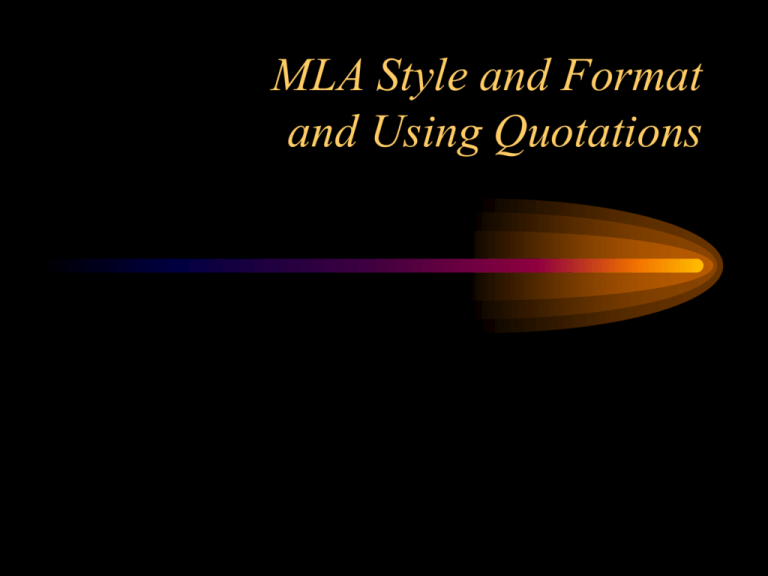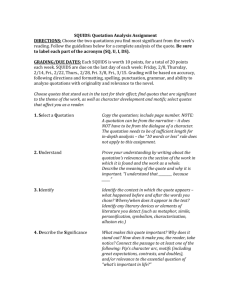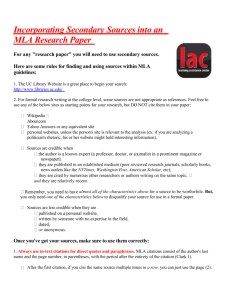MLA Style and Format and Using Quotations References
advertisement

MLA Style and Format and Using Quotations References For all questions regarding style and documentation refer to: • The MLA Handbook for Writers of Research Papers • or your Longwood Style Manual References for Literary Advice For other helpful advice regarding writing literary essays see: • Barnet, Sylvan. A Short Guide to Writing About Literature • Roberts, Edgar. Writing Themes About Literature • or your English 101 textbook Formatting the Paper • No title pages: According to MLA style, a paper does not present a title page. Margins, Spacing, Justification • Margins: One inch margins all around the page. • Spacing: This is very simple, doublespace the entire paper. No exceptions. • Justification: Set only left justification. Be sure that the right margin is not justified. Course Info, Headers, Pagination • Course Info: Begin one inch from the top of the first page and flush with the left margin and include your name, the instructor's name, the course number, and the date on separate lines. • Headers: You must include a header in the top right hand corner of each page after the first page. The header should include your last name and the page number. Fonts Remember that essay writing is a formal activity. Choose a font that has a formal and professional look to it. Here are a few suggested fonts: Arial Bookman Courier Times New Roman Century Fonts-2 Avoid fonts that you feel suggest something about you; remember that the paper should focus on ideas rather than on you. Avoid fonts like these: Comic Sans Ms Creepy Staccato Titles • Format: Double space down from course information and center the title. • Content: Remember the title is the reader’s first impression. Make it specific, full-bodied and interesting. • Example: The Search for the Holy Grail: Religious Imagery in Fitzgerald’s The Great Gatsby Handling Quotations Selection "While quotations are common and often effective in research papers, use them selectively. Quote only words, phrases, lines, and passages that are particularly interesting, vivid, unusual, or apt, and keep all quotations as brief as possible. Overquotation can bore your readers and might lead them to conclude that you are neither an orignal thinker nor a skillful writer" (MLA 56). Short Passages Quoting a passage which is shorter than four lines and is to be incorporated as part of your sentence: Hawthorne emphasizes the prying character of Roger Chillingsworth early in the novel: "The eyes of the wrinkled scholar glowed so intensely upon her, that Hester Prynne clasped her hands over her heart, dreading lest he should read the secret there at once" (Hawthorne 76). Punctuation and Documentation Hawthorne emphasizes the prying character of Roger Chillingsworth early in the novel: “The eyes of the wrinkled scholar glowed so intensely upon her, that Hester Prynne clasped her hands over her heart, dreading lest he should read the secret there at once” (Hawthorne 76). Note the positions of the quotation marks, citation, and period at the end of the sentence. If the quotation ends with an exclamation point or question mark, that punctuation is included INSIDE the quotation mark. The period after the parenthetical reference is also retained. Longer Passages Quoting a passage which is four lines or longer (in your text) requires offsetting that passage and indenting ten spaces from the left margin): It was so artistically done, and with so much fertility and gorgeous luxuriance of fancy, that it had all the effect of a last and fitting decoration to the apparel which she wore; and which was of a splendor in accordance with the taste of the age, but greatly beyond what was allowed by the sumptuary regulations of the colony. (Hawthorne 54) The offset quotation should be double-spaced. Note that there are no punctuation marks after the closing parenthesis in this case and there are no quotations marks around the text itself. Pagination and Quotation Quoting a passage which spans two pages of the original text: . . . "read the secret there at once" (Hawthorne 76-77). Dialogue in Quotations If you quote something a character says, use double quotation marks on the outside ends of the quotation to indicate that you are quoting a portion of the text. Use single quotation marks inside the double quotation marks to indicate that someone is speaking. "'Thou art not my child! Thou art no Pearl of mine!’" (Hawthorne 97). If you cite a passage of dialogue which comprises four lines or more in your text, follow the rule for offset quotation, but remember to use double quotation marks at the beginning and end of the spoken portion to indicate that a character is speaking. Altering Quotations When you quote a passage, you may occasionally want to alter the original text by either deleting some or by supplying your own material to make the sentence grammatically sound or to provide some explanation. Adding and Deleting Text Original: In a sky of iron the points of the Dipper hung like icicles and Orion flashed his cold fires. Altered: Wharton's depiction of the hardness of environment is especially apparent in her description of the “sky of iron [in which]. . .Orion flashes his cold fires.” Brackets are used to indicate your addition. Ellipsis points are used to indicate deleted text. Be sure to space between each ellipsis point. Deletions Across Sentences If you quote from one sentence, skip over some text, and then quote from a later one, you need four ellipsis points to indicate that you've quoted material from two separate sentences: “The village lay under two feet of snow. . . .[and] the Dipper hung like icicles. . . .” Quotations and Poetry • Quote a single line of poetry exactly as you would a single line of prose: Robinson’s “Credo” concludes on a note of hope: “I feel the coming of the Light” (Robinson 14). • Quoting two lines of a poem may be done in the same fashion: The opening lines of “Ulalume” paint a dreary picture of the landscape: “The skies they were ashen and sober:/The leaves they were crisped and sere--” (Poe 14). Poetry and Longer Passages Passages of more than three lines require offsetting. Indent 10 spaces from the left margin unless the poem uses unusual spacing which you would reproduce as accurately as possible. I reason, Earth is short-And Anguish--absolute-And many hurt, But, what of that? (1-4) Unusually Spaced Poems • Reproduce these as accurately as possible. it’s spring and the goat-footed balloonMan whistles far and wee (16-24) For other concerns consult the references







